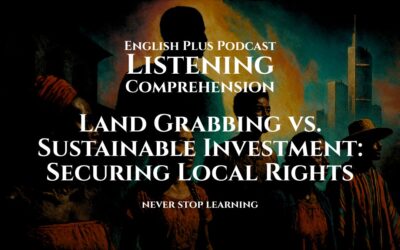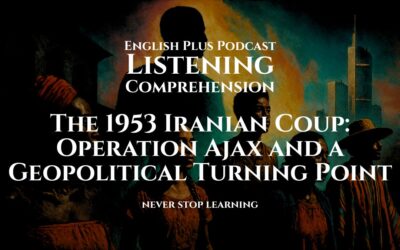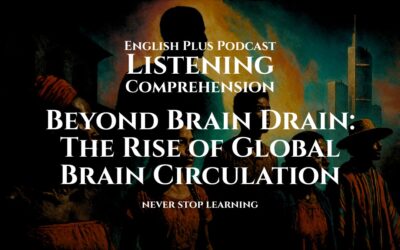Sharpen Your Listening Skills
Welcome to your final listening practice session in this series. Today’s lecture addresses a crucial topic in our interconnected world: the intersection of business and culture. Understanding discussions like this is key for international exams, which often feature topics related to globalization, communication, and social studies.
To get the most from this lecture, apply these powerful listening strategies:
- Listen for Frameworks: The speaker will likely use a model or framework to explain cultural differences, such as the one developed by Geert Hofstede. When you hear a name associated with a theory, pay close attention. Try to note down the key dimensions or parts of the framework they describe.
- Focus on Examples: Abstract concepts about culture can be hard to grasp. The speaker will use concrete examples—like how meetings are conducted or how advertisements are designed in different countries—to make their points clear. These examples are the key to understanding the theory.
- Identify Compare/Contrast Language: The entire lecture is about comparing and contrasting. Be alert for signal words and phrases like “in contrast,” “on the other hand,” “similarly,” “whereas,” and “unlike.” These words are signposts that help you follow the logical structure of the argument.
- Synthesize the Main Message: At the end, ask yourself: what is the ultimate takeaway? The speaker isn’t just listing differences; they are building towards a larger point about what businesses need to do to succeed in a globalized world. Identifying this main message is the highest level of comprehension.
Prepare to listen. The lecture is about to begin.
Listening Audio
Listening Transcript: Please do not read the transcript before you listen and answer the questions.
Good morning. In today’s increasingly globalized marketplace, the notion that “business is business” wherever you go is not just outdated; it’s a recipe for failure. Companies that expand internationally quickly discover that the complex, often invisible, currents of local culture profoundly shape every aspect of their operations, from marketing and sales to negotiations and team management. Today, we will explore this critical intersection of business and culture, examining why cultural intelligence is no longer a soft skill but a core business competency.
To navigate these complexities, it’s helpful to have a framework. One of the most influential is the work of Dutch social psychologist Geert Hofstede. Through extensive research, Hofstede identified several dimensions along which national cultures differ. Let’s touch upon a few key ones. First is the Power Distance Index, which is the extent to which less powerful members of a society accept and expect that power is distributed unequally. In high power-distance cultures, like many in Asia and Latin America, there’s a clear hierarchy. Subordinates are unlikely to challenge their boss openly, and decisions are made from the top down. In contrast, in low power-distance cultures, like those in Scandinavia or Austria, organizations are flatter, communication is more direct, and it’s acceptable for an employee to challenge a manager’s idea. Imagine a German manager, accustomed to direct feedback, being transferred to lead a team in Japan. Without understanding this cultural dimension, the manager might misinterpret their team’s respectful silence as a lack of ideas or engagement.
Another crucial dimension is Individualism versus Collectivism. Individualistic cultures, like the United States or Australia, emphasize personal achievement, individual rights, and “I” consciousness. Business relationships are often transactional. In collectivist cultures, prevalent in many parts of Asia and Africa, the group—be it the family, the community, or the company—is paramount. Identity is defined by “we,” and loyalty and harmony within the group are highly valued. This has massive implications for marketing. An advertisement in an individualistic culture might feature a single person achieving their personal best. In a collectivist culture, a more effective ad would likely show a family or group of friends enjoying a product together, emphasizing harmony and belonging.
A third dimension to consider is Uncertainty Avoidance. This measures a society’s tolerance for ambiguity and unpredictability. Cultures with high uncertainty avoidance, such as Germany or Japan, try to minimize the possibility of the unknown through strict rules, laws, and safety and security measures. In a business context, this means they value detailed planning, precise agendas for meetings, and thorough risk assessment. On the other hand, cultures with low uncertainty avoidance, like Singapore or Denmark, are more comfortable with ambiguity. They are more adaptable, less rule-bound, and more open to change and risk-taking. A business negotiation between two teams from opposite ends of this spectrum can be fraught with misunderstanding; one side’s need for meticulous detail can be perceived as a lack of trust by the other, while the other side’s flexibility can be seen as a lack of seriousness.
These cultural dimensions manifest in tangible ways. Consider marketing blunders. The American car company Chevrolet had trouble selling its Nova model in Latin America; they were unaware that “no va” in Spanish means “it doesn’t go.” Or consider the slogan “Come alive with the Pepsi Generation,” which was reportedly translated in China as “Pepsi brings your ancestors back from the grave.” These are famous, almost humorous, examples, but they illustrate a serious point: a lack of cultural awareness can be incredibly costly.
Beyond marketing, culture dictates negotiation styles. In some cultures, getting straight to the point is valued as efficient. In others, it is crucial to first build a personal relationship, engaging in small talk and sharing meals before any business is discussed. The concept of time itself varies. Monochronic cultures view time as linear—something to be saved, spent, and managed. Meetings start and end on time, and schedules are sacred. Polychronic cultures view time as more fluid; multiple things can happen at once, and human relationships are often prioritized over strict adherence to schedules.
So, what is the key takeaway for modern businesses? It is the imperative to develop cultural intelligence. This means moving beyond simple stereotypes and developing a genuine understanding of, and appreciation for, cultural differences. It involves cultivating empathy, practicing active listening, and adapting one’s own behavior to be more effective in a cross-cultural context. Successful global companies don’t try to impose a single corporate culture everywhere. Instead, they embrace a “glocal” approach—thinking globally, but acting locally. They find the delicate balance between maintaining a consistent global brand identity and adapting their products, practices, and communication styles to resonate with the local culture. In the 21st-century economy, the ability to bridge cultural divides is not just good manners; it is a fundamental driver of sustainable global success.
Listening Quiz
Keywords & Phrases
Intersection
A point or line where lines or surfaces cross; a point where two or more things connect or overlap.
How we used it | The lecture focused on the “intersection of business and culture,” meaning the point where these two fields meet and influence each other.
A recipe for failure
A plan or situation that is doomed to fail.
How we used it | The idea that “business is business” everywhere was called a “recipe for failure.” This idiom strongly suggests that this approach will almost certainly lead to bad results.
Profoundly
To a profound extent; extremely.
How we used it | We said that culture “profoundly shapes” business operations. Using “profoundly” instead of “a lot” adds emphasis and suggests the influence is deep and significant.
Core competency
A defining capability or advantage that distinguishes an enterprise from its competitors. A fundamental skill.
How we used it | Cultural intelligence was described as a “core competency.” This means it’s not just a nice-to-have “soft skill,” but an essential, central capability required for success.
Transactional
Relating to the conducting of business; focused on a particular exchange as opposed to a long-term relationship.
How we used it | Business relationships in individualistic cultures were described as often being “transactional.” This means they can be short-term and focused purely on the deal at hand.
Paramount
More important than anything else; supreme.
How we used it | In collectivist cultures, the group is “paramount.” This highlights that the group’s needs and harmony are the absolute top priority.
Ambiguity
The quality of being open to more than one interpretation; inexactness.
How we used it | Uncertainty avoidance was defined as a society’s tolerance for “ambiguity.” This refers to how comfortable people are with situations that are unclear, uncertain, or unpredictable.
Manifest
To show or demonstrate (a quality or feeling) by one’s acts or appearance; become apparent.
How we used it | The lecture stated that cultural dimensions “manifest in tangible ways.” This means these abstract cultural ideas become visible and real in things like marketing and negotiation styles.
Imperative
A thing of vital importance; a crucial requirement.
How we used it | The key takeaway was called the “imperative to develop cultural intelligence.” This frames the need for cultural understanding as an urgent and absolutely necessary duty for modern businesses.
Resonate with
To meet with agreement or shared feelings; to evoke a feeling of shared emotion or belief.
How we used it | Successful companies adapt their products to “resonate with the local culture.” This means they change them in a way that connects emotionally and feels familiar or right to the people in that culture.










0 Comments